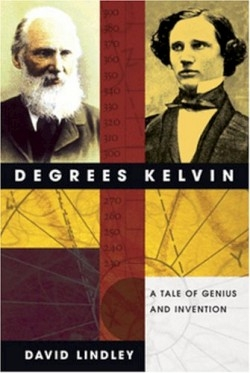Degrees Kelvin
A Tale of Genius Invention and Tragedy
This brilliantly developed biography depicts the life of a virtually forgotten scientist who exemplified practical solutions in an age of philosophical diversions. He was responsible for insights and practices that made him famous and respected in his own time; however, by the end of his life, he was disdained by fellow scientists.
William Thompson, later known as Lord Kelvin, showed early promise when at sixteen he wrote a mathematical paper correcting the conclusions of Philip Kelland, a mathematics professor at Edinburgh. Thompson then attended Cambridge and became a professor. Through his diary and letters between him and family members, readers are given a number of carefully documented descriptions and conversations, which depict college life in the 1840s and the social life of a fast-developing intellectual.
Thompson’s bent for the practical led to teaching methods that brought experimentation to the natural sciences. In 1858 he was the major player in first mathematically proving that a trans-Atlantic cable would work, and then in overseeing the practical aspect of its development and installation. It failed, but not because of Thompson or his work. He went on to add insight to a range of scientific issues such as the source of the sun’s heat, improvements to the compass, and the age of the earth.
The author has a doctorate in astrophysics and has written a number of books aimed at making science understandable to general readers. He also writes for the magazines Discover, New Scientist, and Nature. His diversity makes him especially apt at writing about Kelvin’s wide range of interests, including rowing, a sport that many (including his father) looked on as dubious. He managed to sell the value of this sport to his father, through his diary and letters. The author uses these personal sources to create atmosphere and lend authenticity to his narrative.
Another of Kelvin’s more scientific interests was how heat flows; by applying mathematical methodologies and mechanical theory to how early thermometers worked, he helped develop the theory of thermodynamics. Kelvin theorized that temperature could be defined in mechanical terms, so there was a theoretical unit of temperature that could be used to make accurate measurements. Lindley brings this complex process of theoretical development together by quoting scientific papers by Kelvin and others.
Toward the end of his life, Kelvin became rigid in his views, often ignoring the scientific process he had fought for in his earlier days; he eschewed Darwin and argued that the earth is younger than the evidence that was beginning to be developed by science. In the end he began to exchange the practical application of science for the theoretical diversion of unscientific speculation. It is the fall of a brilliant life told compellingly and compassionately by an entertaining and convincing storyteller.
Reviewed by
Joe Mielke
Disclosure: This article is not an endorsement, but a review. The publisher of this book provided free copies of the book to have their book reviewed by a professional reviewer. No fee was paid by the publisher for this review. Foreword Reviews only recommends books that we love. Foreword Magazine, Inc. is disclosing this in accordance with the Federal Trade Commission’s 16 CFR, Part 255.

